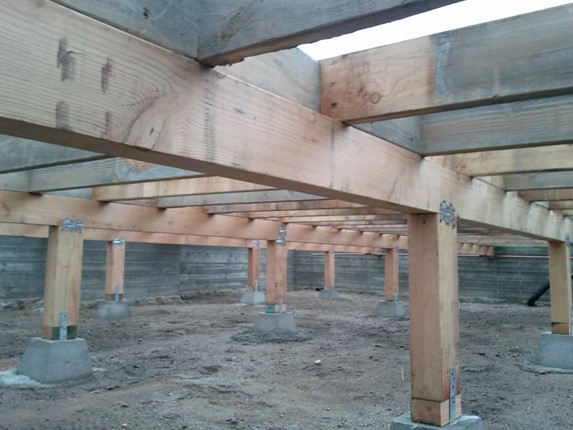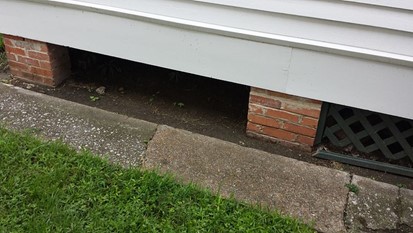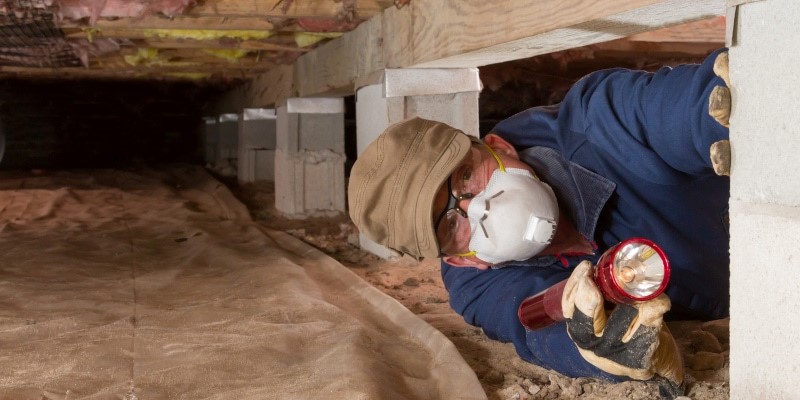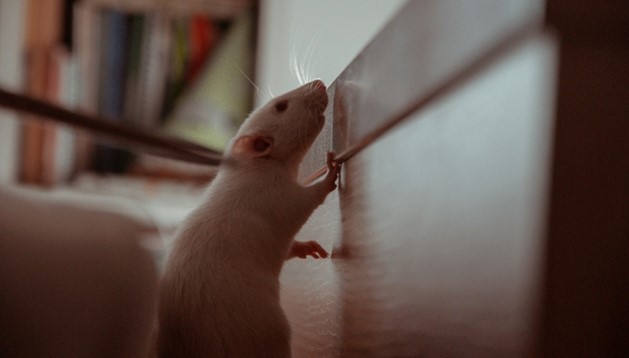October 19, 2020 by Lexi Klinkenberg
Crawl spaces are often out of sight and, consequently, out of mind, making them easy to neglect. But without proper maintenance your crawl space is susceptible to moisture, heat loss, pests, and a host of other complications. These common problems can damage your home’s foundation, cause sky-high energy bills, and introduce toxins into the air you breathe. With as much as 40% of the air in your home originating from your crawl space, keeping up on your crawl space maintenance plays a big role in the air you breathe and the long-term health of your home.
What is a Crawl Space?

A crawl space is a small area, ranging from one to three feet in height, that resides between the bottom floor of your home and the ground. A crawl space provides extra room for your home’s electrical wiring, plumbing components, and HVAC equipment. The height of the crawl space is limited, and getting into the area must be done by crawling, either on your stomach or your hands and knees. If you’re a prospective buyer or own a home in close proximity to water or near a marsh, exploring the crawl space is a necessary part of a home inspection. So, if you’re considering moving to somewhere like Miami, FL, don’t overlook the crawl space when making an offer on a home.
What’s the Difference Between Crawl Space vs. Basement?
Crawl spaces are typically used in damp climates, where the ground is regularly too wet for basement construction. Supporting the home off of the ground keeps it away from moisture that could cause damage. In coastal areas where the soil is sandy, a crawl space can alleviate potential basement problems, like excessive water buildup that could put pressure on basement walls. Crawl spaces are also sometimes preferred in construction when a basement is too costly. Installing a crawl space is cheaper than installing a basement.

A basement is a popular type of foundation that can add space and functionality to a home. Basements are often used as storage space, living areas, or both. A basement combines elements of a slab and crawl space. The floor in a basement is very similar to slab concrete, and the support system used under the basement floor is the same as what is used in a crawl space. Although basements can be a great addition to a home, they cannot be built in areas with high moisture levels or unsettled soil. They also happen to be the most expensive type of foundation to build.
Crawl Space Solutions for Common Problems
Problem: Moisture
Homes with poor ventilation are more susceptible to crawl space issues than others. Without regular evaluation and crawl space maintenance, you may not know there is a problem until it’s too late. Signs of excessive moisture throughout the home are often readily noticeable, but signs of moisture in your crawl space may be harder to detect. Unfortunately, moisture in a crawl space can be just as problematic, causing complications such as mildew, dust mites, mold, and wood rot. When there is nowhere left for moisture to go within a crawl space, it can then travel into your insulation, flooring, and walls to create even larger problems. Crawl spaces with exposed dirt most commonly have trouble with an excess of moisture.
Solution: Vapor Barrier
A vapor barrier is one of the best ways to protect your home against the encroachment of moisture. Essentially a large plastic sheet placed over the base of a crawl space, vapor barriers are intended to fully cover any exposed dirt. While this doesn’t completely eliminate moisture, it does slow the process significantly. At 50 to 70 cents per square foot, sheet plastic is a cost-effective barrier for moisture in your crawl space. A vapor barrier can be a DIY project if you’re willing to get down and dirty, but the labor that goes into covering the entire ground area can be challenging to accomplish on your own. You’ll need a friend to help you pass the rolls of sheet plastic back and forth through the crawl space, or if this sounds too labor-intensive, a professional contractor may be the way to go.
Solution: Encapsulation
If a vapor barrier alone isn’t enough to tame moisture and ventilation problems, encapsulation can be a great alternative. The first step in this process involves a vapor barrier coupled with sealing tape and coverage of walls and ceiling areas. A complete encapsulation includes drain tile, a sump pit and pump, concrete, insulation, and a dehumidifier to properly condition the air.
While placing a vapor barrier can be done independently, encapsulation is best handled by a professional. The installation process takes expertise, and installing a dehumidifier is best left to a trained technician. The costs of hiring a contractor for this work varies by home size and region of the country.

Problem: Energy Loss
A crawl space isn’t a livable part of the home, but insulation is still important to keep the heat in. Crawl spaces can be a major source of energy loss. If you find yourself running your furnace all winter long, driving up high energy bills, yet still feel cold on the ground floor of your home, your crawl space could be the issue. If your crawl space isn’t properly insulated from the cold, you could be wasting energy and driving up your utility bills. If you want to live more sustainably and save money on heating bills, you should consider insulating your crawl space.
Solution: Insulation
Insulating your crawl space depends on the general climate in your area. In warm or dry areas, insulation can be limited to just the area between the floor joists. However, in subfreezing temperatures, insulating the walls and sealing off the crawl space is most effective. A professional can evaluate the state of your crawl space, make a recommendation, and handle the insulation process.
Problem: Pests
Rodents and insects can be a problem anywhere in your home, and a crawl space is no exception. Crawl spaces can easily become a dwelling for pests if they are not properly maintained. Since most homeowners do not spend much time in their crawl space, it may be harder to determine if there is a pest problem. Pests such as mice, rats, termites, carpenter ants, spiders and more have the ability to damage insulation, crawl through vapor barriers, dig into wood, and even tunnel into your main living spaces.
Solution: Pest Control

Proper crawl space maintenance, including encapsulation, can keep your property safe from pests. When all entrances and exits are sealed, the possibility of rodents and insects gaining entry to your home is almost impossible. If you do see signs of pests, partnering with an exterminator can treat problems at the source.
Crawl Space Inspection Checklist
A crawl space inspection is typically included in a standard home inspection when buying or selling a house. This is an area where issues tend to arise and can throw a wrench in the home sale. Both home sellers and buyers should be aware of the state of the crawl space in order to mitigate any potential problems prior to the sale. Here are the red flags that professionals look for during a crawl space inspection:
- Electrical wiring issues
- Plumbing issues
- Moisture (standing water, damp insulation, or warped building materials)
- Pests (Bugs, termites, rats, mice)
- Mold and mildew
- Ventilation issues
- Cracks in the foundation
As a seller, you may want to have your crawl space inspected prior to listing it on the housing market. That way you are aware of any issues and can have them fixed before the sale, or adjust the sale price accordingly
As a homeowner, maintaining your crawl space is critical to the health and longevity of your home. That means doing an annual inspection and attending to problems as they arise, as well as taking preventative measures to keep your house healthy. If crawling under your home doesn’t seem like fun, you can always partner with the pros and hire someone to ensure your crawl space is in good hands. With these tips and fixes, you can be sure the foundational part of your home is properly maintained for years to come.
If you have any questions about your crawl space needs, please reach out to Hausmeister, LLC at 425.622.8869
